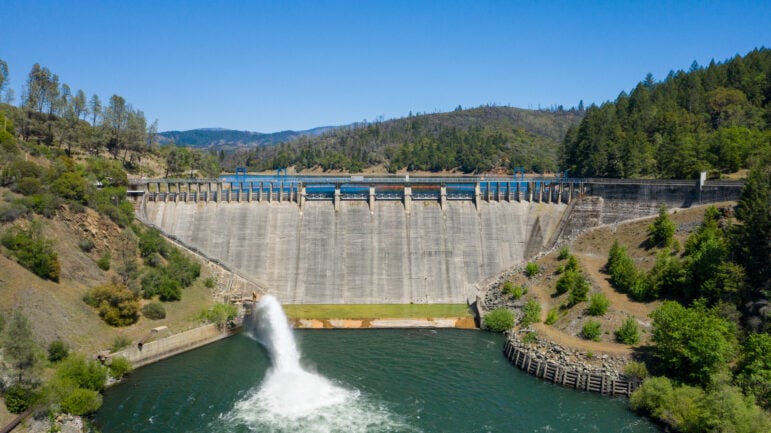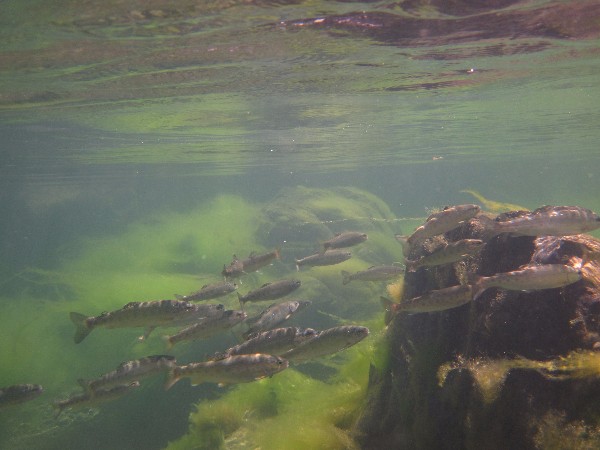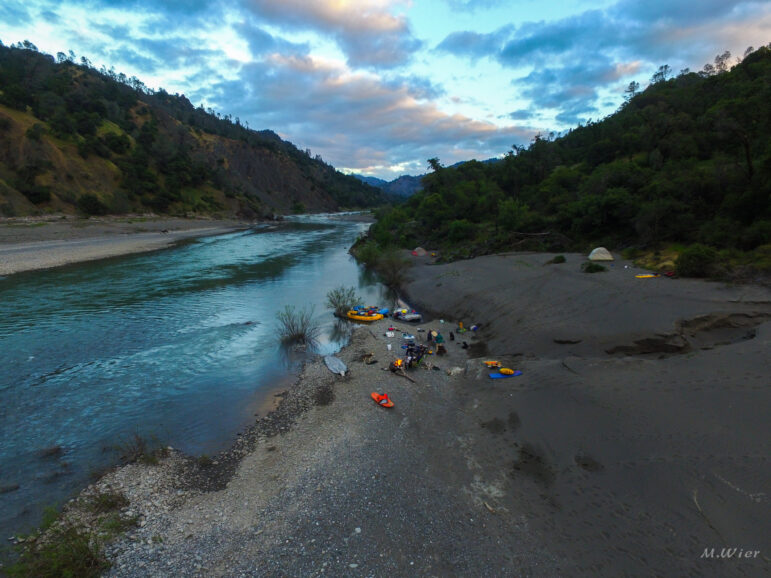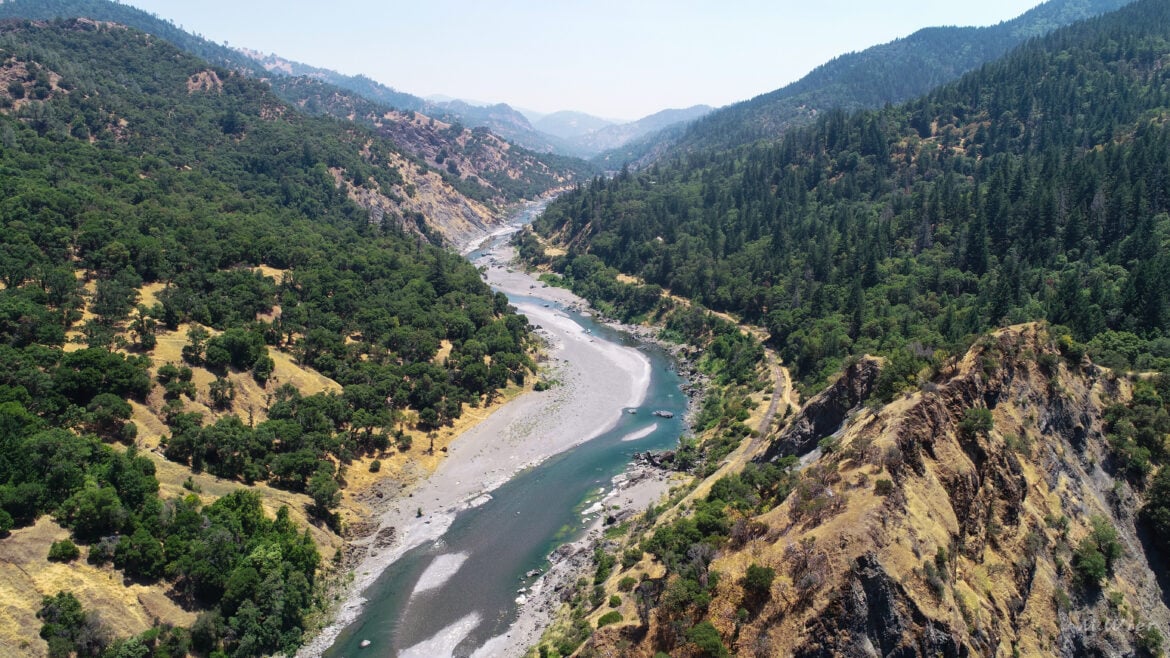MENDOCINO Co, CA, 4/18/23 — For Nikcole Whipple, an Indigenous law student and member of the Round Valley Indian Tribes, talking about the Eel River means talking about her family. She remembers traveling into the mountains with her dad and grandmother to care for elders in the community, driving over “bellyache slide,” a bumpy roadway that perennially washed out because of its proximity to the water. Her mom always taught her to be proud of their river, and learning about its water issues at tribal council meetings inspired her to further explore environmental policy — which she is doing now as an intern with Save California Salmon.
She’s also seen the Eel’s water contaminated, with water from the river piped to low-income housing developments on the reservation turning an orange hue at times. In recent years, on her drives in and out of the valley, seeing almost no water in the Eel has been “devastating.”
“I hope that we can get our water back — and get our culture back,” she told The Mendocino Voice in a phone conversation. “We were fish people, just like the rest of the far north people. That was our food and we lived off that land, and that included the river.”
In 2023, the Eel River has been named one of America’s Most Endangered Rivers by the nonprofit American Rivers. The organization publishes this list of ten rivers each year based on criteria including the rivers’ significance to people and nature, the magnitude of threat to the watershed and its communities, and — most critically — whether the public can influence an important upcoming decision on the river’s future.
For the Eel, that’s the decommissioning of the Potter Valley Project, which Pacific Gas & Electric (PG&E) is currently in the 30-month-long process of planning. The project — originally a hydroelectric project built in the 1920s, though it no longer provides power — consists of two dams that divert water from the Eel River to the Russian River, benefiting some 86 water users in the latter watershed. The conditions Whipple described aren’t just the outcomes of record-breaking drought — they’re direct fallout from infrastructure in place over the past century.
“For 100 years now, these dams have helped one watershed at the expense of the other,” said Alicia Hamann, executive director of Friends of the Eel River, in a phone call with The Voice. “They not only pose an ongoing risk to the survival of the fisheries in the Eel watersheds, but they pose an ongoing risk to downstream residents.”
Scott Dam is one of numerous dams nationwide rated as a high hazard facility, meaning that loss of life is possible in the event of dam failure. Recently, PG&E announced that it would be keeping the spillway gates open and storing less water at its adjoining reservoir, Lake Pillsbury, because of enhanced risk of seismic activity at the site.
Should both Scott Dam and Cape Horn Dam be removed, the Eel, at 196 miles, would become California’s longest free-flowing river. It’s the state’s third largest watershed, and was historically one of the most productive salmon rivers in the continental U.S. The Eel is the ancestral home of tribal groups including the Cahto, Pomo, Lassik, Nongatl, Sinkyone, Wailaki, Wiyot, and Yuki peoples, as well as the current home of tribes forcibly moved to the area in the early 20th century.
“We have a sacred duty to restore the Eel River, which has provided food, culture and a way of life since time immemorial,” Round Valley Indian Tribes Tribal Council President Randall Britton said in a statement. “The health of the river and the health of our people go hand in hand. We have suffered as the river, and our tribal fishery, have suffered from dams, poorly timed diversions and bad land management decisions. A free-flowing, restored Eel River will help revitalize our culture and economy.”

In its report on the Eel, American Rivers cited loss of culturally and economically important fish runs, habitat deterioration, and reduced water quality and quantity as some of the dams’ negative impacts.
“Additionally, the way the dams are managed causes fish to struggle at key moments in their life cycle due to low water flows associated with out of basin diversions, inhospitable water temperatures caused by the reservoirs, water quality degradation including toxic algae outbreaks, excessive predation at a poorly designed fishway, and the proliferation of invasive species,” the nonprofit wrote.
Hamann was one of at least two people to independently nominate the Eel for consideration by American Rivers, the other being Charlie Schneider of California Trout. River groups and concerned citizens nationwide can nominate rivers for the Most Endangered Rivers list, to garner wider attention for localized water issues and community impacts. Hamann heard about the opportunity when the Free the Eel Coalition recently expanded to include some larger advocacy groups.
She said sometimes the “big greens,” or larger nonprofits, can sweep in and secure funding or take on projects based on groundwork laid by smaller organizations — so she appreciates how American Rivers helps spotlight local work without taking credit.
“They’ve done a really great job of going out of their way to ensure that a wide diversity of voices are represented when talking about why the Eel matters to all of us,” she said.
Advocates have long pushed for dam removal along the Eel, citing adverse conditions for threatened and endangered fish species — especially Chinook salmon, coho salmon, and steelhead trout, all of which are listed under the Endangered Species Act (ESA). In 2022, the National Marine Fisheries Service (NMFS) wrote to the Federal Energy Regulatory Commission (FERC) that “take” of these species by the dam conditions was unauthorized, leading fishing and conservation groups to sue FERC under the ESA.
Glen Spain, acting executive director and general counsel for Pacific Coast Federation of Fishermen’s Associations (PCFFA), has seen dramatic declines in the health of salmon fisheries in his 40 years with the PCFFA. He also pointed out that when salmon in even one river suffer, large spans of the coast are impacted.
“Forty years ago, the number of permits for ocean trawling salmon boats was about 4,500,” he told The Voice in a phone conversation. “Today, there are just about 1,000 permits, of which only about half of them are engaged on a full-time basis in the fishery. So the takeaway is, we’ve lost about 80% of our fleet — because over that last 40 years, we’ve lost about 80% of our salmon.”
In the Eel specifically, recent returns have shown protected fish populations of salmon and steelhead at less than 10% of their historic levels. While overfishing of salmon in the Pacific was a problem in the 1800s and early 1900s, from where Spain’s standing, the industry has compensated to bolster healthy fish populations. But inland factors have continued to harm salmon, especially during spawning: he cites harmful chemicals from agriculture, increasing sediment buildup from logging and roads, and habitat loss from flow diversions like those at Potter Valley.
“We are stewards of the fisheries,” Spain said. “It’s our responsibility to pass sustainable fisheries, intact, on to future generations. … We use environmental laws, because the environmental laws are there to protect river systems, and those river systems mean jobs and dollars for our communities. It’s a perfect example of why it is true that strong environmental protections protect your economy.”

Whipple has loved learning more about salmon and advocating in different California watersheds in her internship with Save California Salmon. But when thinking about the Eel specifically, she appreciated what a natural resources director with the Wiyot Tribe had to say at a recent meeting she attended.
“She shared that — not to take away from the salmon — but we really need to take off the ‘salmon lenses,’ and realize and acknowledge that salmon is only one of our creatures and species that needs protection,” Whipple recalled. “There are so many more, including the [lamprey]s, the crawdads, the freshwater clams … we all lived off of those. They’re part of our traditional items and regalia used for ceremonies, and our gift economy.”
This impact is part of why “tribal and cultural sustenance,” in addition to “fish and wildlife,” is one of American Rivers’ highlighted risks on the Eel River.
“Today Indigenous people, just like our lands and water, suffer from sickness and disease due to the foreign substances we consume,” Whipple wrote in an email to The Voice. “We, our lands, our fish and water species, and our bodies cannot adapt or evolve to accept all of this pollution — this is the science that needs to be gathered and shared in environmental impact reports, and the science supporting climate change.”
PG&E has committed to decommissioning the Potter Valley Project, but not necessarily dam removal. But American Rivers does not shy away from prescribing the removal of both dams as the solution.
“PG&E’s decision to surrender their license to operate the dams and decommission the project is an enormous opportunity to remove obsolete unsafe dams that endanger downstream communities, facilitate salmon recovery, restore cultural connections, revitalize an important commercial and recreational fishery, and reconnect what would be California’s longest free flowing river,” the report on the Eel River stated. “PG&E must expedite the next step towards restoring this river and its communities by removing both dams, repairing the damage they have caused, and ensuring the safety of downstream communities.”
American Rivers also encouraged FERC to hold PG&E accountable for these measures.
The operation of the Potter Valley Project has long been controversial, given the multiple counties, watersheds, tribes, farmers and ranchers, and communities involved. On the Russian River side, water leaders recently established the Russian River Water Forum, designed to be a body that can continue regional negotiations and perhaps produce an entity to take over the project. Much of the agriculture in the watershed has developed entirely out of the existence of the Potter Valley Project; no diversions at all would be a big change. Janet Pauli of the Potter Valley Irrigation District Board of Directors told The Voice last month that she’s been part of exploring other water sources, such as raising Coyote Valley Dam or engineering a new dam in Potter Valley to augment water storage: “There’s a lot of work that still has to be done to ensure that is possible.”
But Eel River interest groups emphasize that dam removal in the Eel is in some ways less complicated than other high-profile projects like that on the Klamath River, where dam removal will go forward as of a landmark approval in 2022. (The Klamath was named a Most Endangered River back in 2003). The Klamath crosses both Oregon and California, and also has four dams.
“There’s a lot of reason to hope that our dam removal process will be much quicker,” Hamann said. “It’s a lot more straightforward, and the extent to which the water has competing uses like it does in the Klamath is much less in the Eel.”
Spain, who is also working on the removal process in the Klamath, agreed. He also feels that the North Coast’s surrounding rural landscape is an asset to these types of large infrastructure changes.
“If we remove the dams, we can restore that river,” he said. “Most of the pieces are still there. It’s not over-urbanized.”
For Meghan Quinn, the associate director of river restoration and dam removals for American Rivers’ California program, balancing many interests in the nonprofit’s advocacy is important. She’s hopeful about groundwater and water storage solutions for the Russian River that no longer perpetuate harm to Eel River communities.
“American Rivers’ overall policy is to make all river users whole,” she told The Voice. “We like to bring a broad base of stakeholders to the negotiating table, hear about their concerns, hear about how they use the river, and really make sure that as we create a plan for removal of a dam, that we are addressing each one of those concerns in a really thoughtful way. The Eel River is no different.”
Quinn is optimistic about the impact of the Eel River’s listing, in terms of how the public engages with the decommissioning plan still to come; it’s a moment that could be “historic.”
“We’re really hoping that we can use this campaign to encourage [PG&E] to do the right thing for the people and resources of California,” Quinn said. “I want this to be a story of hope and opportunity.”
Read the full report on 2023’s Most Endangered Rivers in America.

Note: Kate Fishman covers the environment & natural resources for The Mendocino Voice in partnership with a Report For America. Her position is funded by the Community Foundation of Mendocino, Report for America, & our readers. You can support Fishman’s work with a tax-deductible donation here or by emailing [email protected]. Contact her at KFishman@mendovoice.com or at (707) 234-7735. The Voice maintains editorial control and independence.





This article is nothing more than enviromental propaganda, aimed at destroying Lake Pillsbury. Full of half truths and outright lies.
Scott Dam was constructed in 1922. There were plenty of Salmon and water on the Eel until the 1964 flood. Numbers decreased after that but the article fails to even mention the biggest culprit. That is illegal marijuana grows that steal water from North and South Forks of the river. This is the real cause for lack of flow. Everybody in the Emerald Triangle knows this to be true.
The referenced report was created by American Rivers, who is part of a larger coalition that is set on dam removal. There are multiple reasons that the Eel River is in bad shape, e.g., historical logging and floods, pollution, cannabis grows, sediment. To blame the demise of the Eel and the fishery closure on Scott Dam is ludicrous. The terrain above Scott Dam is the hottest and driest area in the Eel River watershed. The Eel River above Scott Dam is known to intermittently dry up in the late summer and fall months until the rains come. It is Scott Dam and Lake Pillsbury that assure water flows year round in the Eel. A case of be careful what you wish for….
There are multiple reasons that the Eel River is in bad shape, e.g., historical logging and floods, pollution, cannabis grows, sediment. To blame the demise of the Eel and the fishery closure on Scott Dam is ludicrous. The terrain above Scott Dam is the hottest and driest area in the Eel River watershed. The Eel River above Scott Dam is known to intermittently dry up in the late summer and fall months until the rains come. It is Scott Dam and Lake Pillsbury that assure water flows year round in the Eel. A case of be careful what you wish for….
Thank you Mendo Voice for this reporting. It is great to read a piece that includes Native voices like those of Nikcole Whipple and Randall Britton. Tribes have moral authority in conversations about the future of local rivers and fisheries and I think many folks who live in Northern California are ready to listen. And to the above comments: of course removal of the dams will benefit river health and Salmon habitat! I have seen the river upstream from the reservoir, next to the Snow Mountain Wilderness. We all know fish would return to that area if dams were removed.